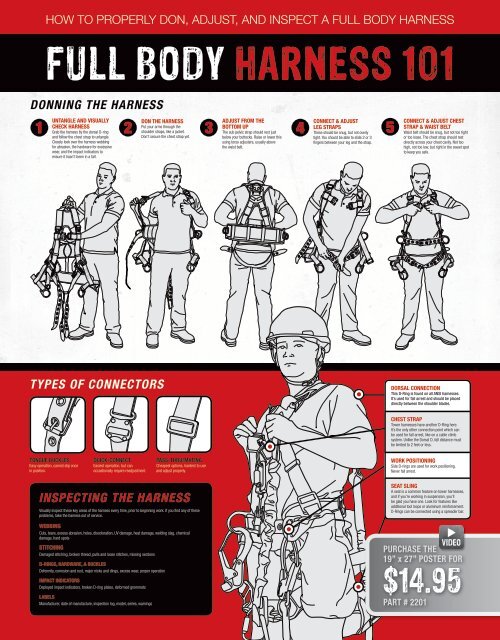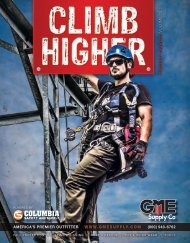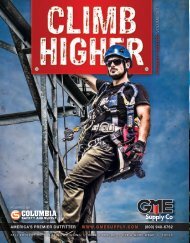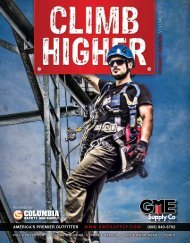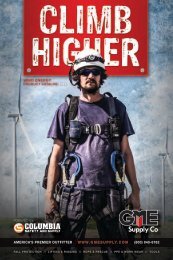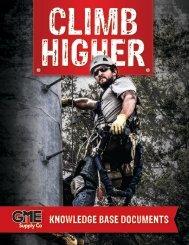GME Supply Product Catalog Version 18.2
GME Supply is North America's premier outfitter of fall protection, safety equipment, and gear for at-height workers, industry, and construction.
GME Supply is North America's premier outfitter of fall protection, safety equipment, and gear for at-height workers, industry, and construction.
Create successful ePaper yourself
Turn your PDF publications into a flip-book with our unique Google optimized e-Paper software.
HOW TO TO PROPERLY DON, ADJUST, AND INSPECT A FULL BODY HARNESS<br />
FULL BODY HARNESS 101<br />
donning THE HARnESS<br />
1<br />
Untangle and VisUally<br />
CheCk harness<br />
Grab the harness by the dorsal D-ring<br />
and follow the chest strap to untangle.<br />
Closely look over the harness webbing<br />
for abrasion, the hardware for excessive<br />
wear, and the impact indicators to<br />
ensure it hasn’t been in a fall.<br />
2<br />
don the harness<br />
Put your arms through the<br />
shoulder straps, like a jacket.<br />
Don’t secure the chest strap yet.<br />
3<br />
adjUst From the<br />
Bottom Up<br />
The sub pelvic strap should rest just<br />
below your buttocks. Raise or lower this<br />
using torso adjusters, usually above<br />
the waist belt.<br />
4<br />
ConneCt & adjUst<br />
leg straps<br />
These should be snug, but not overly<br />
tight. You should be able to slide 2 or 3<br />
fingers between your leg and the strap.<br />
5<br />
ConneCt & adjUst Chest<br />
strap & waist Belt<br />
Waist belt should be snug, but not too tight<br />
or too loose. The chest strap should rest<br />
directly across your chest cavity. Not too<br />
high, not too low, but right in the sweet spot<br />
to keep you safe.<br />
TYPES oF ConnECToRS<br />
dorsal ConneCtion<br />
This D-Ring is found on all ANSI harnesses.<br />
It’s used for fall arrest and should be placed<br />
directly between the shoulder blades.<br />
Chest strap<br />
Tower harnesses have another D-Ring here.<br />
It’s the only other connection point which can<br />
be used for fall arrest, like on a cable climb<br />
system. Unlike the Dorsal D, fall distance must<br />
be limited to 2 feet or less.<br />
tongUe BUCkles<br />
Easy operation, cannot slip once<br />
in position.<br />
QUiCk-ConneCt<br />
Easiest operation, but can<br />
occastionally require readjustment.<br />
pass-thrU/mating<br />
Cheapest options, hardest to use<br />
and adjust properly.<br />
work positioning<br />
Side D-rings are used for work positioning.<br />
Never fall arrest.<br />
inSPECTing THE HARnESS<br />
Visually inspect these key areas of the harness every time, prior to beginning work. If you find any of these<br />
problems, take the harness out of service.<br />
weBBing<br />
Cuts, tears, excess abrasion, holes, discoloration, UV damage, heat damage, welding slag, chemical<br />
damage, hard spots<br />
stitChing<br />
Damaged stitching, broken thread, pulls and loose stitches, missing sections<br />
d-rings, hardware, & BUCkles<br />
Deformity, corrosion and rust, major nicks and dings, excess wear, proper operation<br />
impaCt indiCators<br />
Deployed impact indicators, broken D-ring plates, deformed grommets<br />
laBels<br />
Manufacturer, date of manufacture, inspection log, model, series, warnings<br />
seat sling<br />
A seat is a common feature on tower harnesses,<br />
and if you’re working in suspension, you’ll<br />
be glad you have one. Look for features like<br />
additional tool loops or aluminum reinforcement.<br />
D-Rings can be connected using a spreader bar.<br />
PURCHASE THE<br />
19” x 27” POSTER FOR<br />
$14.95<br />
PART # 2201


